#sillicon valley edit
Text

#silicon valley#fy#series#best series forever#season#funny#sillicon valley hbo#sillicon valley edit#need#hbo#dinesh x gilfoyle#bertram gilfoyle#dinesh
31 notes
·
View notes
Text
The Meaning of the Cryptic Messages on The Economist’s “The World in 2019” Cover
A look at the cryptic symbolism found on the cover of the Economist’s “The World in 2019” which includes the Four Horsemen of the Apocalypse. What are they trying to tell us?
Every December, the reputed magazine The Economist publishes a special edition that predicts the trends and the events of the year to come. And every time, the cover of these editions is an elaborate collection of images referring to various people and concepts. While the meaning of some of these images is obvious, others appear to be coded for “those in the know”. This year’s edition is no exception. In fact, it is more cryptic than ever.
Why would anybody spend time deciphering these covers? Because The Economist isn’t just any publication – it is directly connected with the world’s elite. It is partly owned by the Rothschild banking family of England and its editor-in-chief, John Micklethwait, has attended the Bilderberg Conference several times. In short, the leadership at The Economist has inside knowledge of the elite’s agenda, and they do their best to promote it.
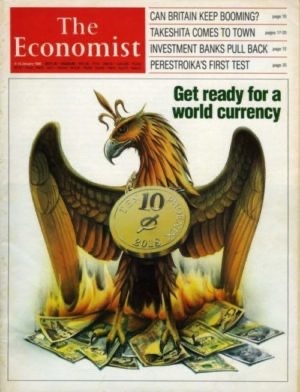
This 1988 cover of The Economist called for the creation of a world currency called the Phoenix – one of the occult elite’s favorite symbols. The bird stands on a pile of burning national currencies.
As seen in my articles about the 2015 and 2017 editions of The Economist, these covers are often replete with occult elite symbolism, mixed with subtle messages about the many ways the elite controls the masses. The 2019 edition is more blatant than ever.
The World in 2019
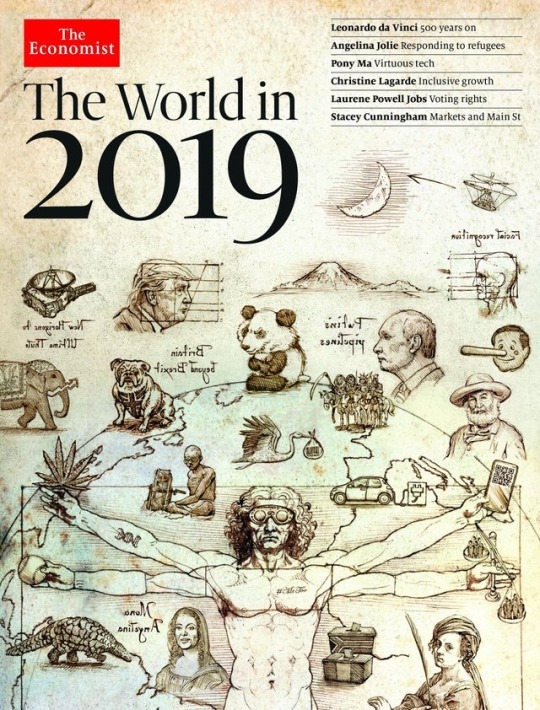
This is the description posted by The Economist on its official website:
The World in 2019 will build on three decades of publishing success: this will be the 33rd edition. It will look ahead to the Trump administration’s prospects with a new Congress, the reality of Brexit, elections in India, Indonesia, Nigeria and across Europe, tech disruptions from AI and China (could 2019 mark “peak Sillicon Valley”?), space travel 50 years after the Moon landing and culture 500 years after Leonardo da Vinci.
Note that the description emphasized the fact “this will be the 33rd edition”. Why emphasize this random numerological this fact? Is it because 33 is the most important number in Freemasonry? That would make sense because the cover features intense Masonic symbolism through the works of Leonardo da Vinci.
Leonardo da Vinci
The main theme of this cover is Leonardo da Vinci because 2019 will mark the 500th anniversary of his death. As such, the art style is made to look like a da Vinci manuscript.
The first detail that one might notice is the mirror writing. Why is everything written backward? Well, da Vinci often wrote in mirror writing and the reason he did that remains a mystery. Some claim that he did not want to smudge ink while he was writing; others believe that he did not want other people to steal his ideas. Those who have researched Vinci’s occult leanings believe that his backward writing might have something to do with him attempting to conceal esoteric knowledge. In his day, those who accused da Vinci of being a heretic even called his mirror script “writings of the devil”. In occult circles, mirror writing is often associated with Satanism and black magic, based on the reversal of symbols. Let’s look at the symbolism of the cover.
The Vitruvian Man
At the center of the cover is the Vitruvian Man, da Vinci’s famous sketch depicting a man stretched out inside a circle and a square. It is said to be a representation of “the perfect man”.
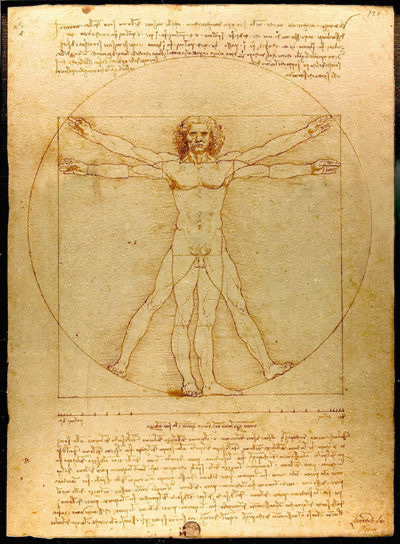
The original Vitruvian Man with da Vinci’s comments in mirror-writing.
While the Vitruvian Man is often described as a “study of human proportions”, it bears a much deeper symbolic meaning in occult circles – especially in Freemasonry. It esoterically represents the human body (the microcosm) as a reflection of the entire universe (the macrocosm) – a hermetic principle summed up by the saying “As Above, So Below”.
Da Vinci’s sketch was based on the works of Vitruvius, a Roman architect who was considered to be the “First Grand Master” of Freemasonry. Appropriately enough, the Vitruvian Man visually depicts the ultimate goal of Freemasonry: Squaring the circle.
In Masonic symbolism, the square represents the physical body and the circle represents the soul. On a wider scale, the square represents the material world, while the circle represents the spiritual realm. One of the goals of Freemasonry is to harmonize these two opposite worlds (physical and spiritual) to create the “perfect man”. This concept is fully represented in the logo of Freemasonry.
The Meaning of the Cryptic Messages on The Economist's "The World in 2019" Cover

The Masonic square and compass.
The logo of Freemasonry combines a square and a compass – two tools used in architecture. The square is used to draw squares while the compass is used to draw circles. By “squaring the circle”, the Freemason is said to achieve godhood.
I won’t go deeper in the connections between da Vinci and occultism because that would require an entire book (and I’m not talking about The da Vinci Code). Let’s just remember that, for its 33rd end-of-year edition, The Economist features a “modern” Vitruvian Man.
The 2019 Vitruvian Man wears night-vision goggles, or maybe a VR headset. Is his sight being improved or is he being blinded? In his hands, he holds a leaf of cannabis, a baseball, and a smartphone. One could argue that all of these things are used to distract and pacify the modern man through drug companies, big tech, and entertainment.
The Vitruvian Man also has two tattoos. On his forearm is a double-helix, the symbol representing DNA. This is most likely a reference to the intense research in DNA modification happening in the private sector. Was the Vitruvian Man’s DNA altered?
Across his heart is tattooed “#MeToo”. While the #metoo movement did expose some Hollywood creeps, it also has created a climate of censorship and repression where many people have accused, judged, and sentenced to expulsion in the public sphere.
On a somewhat related note, the Vitruvian Man holds a scale – a classic symbol representing justice. However, the scale is heavily slanted on the side that has 5 people versus 4. Is this the U.S. Supreme Court, who recently gained a new and controversial judge, or is this just the tilted scales of justice in 2019?
Overall, the modern Vitruvian Man appears to be blinded, weakened, distracted, and repressed. The circle around him that once symbolized the spiritual realm is now the Earth. Did the Vitruvian Man lose his soul? Is he now concerned only with Earthly matters?
Facial Recognition
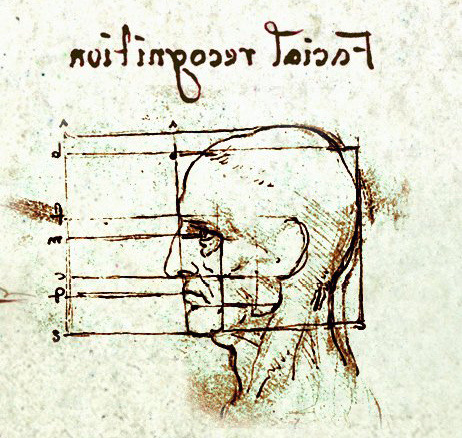
The cover features an exact replica of da Vinci’s sketch analyzing the proportions of the human head. Above the image is written (in reverse) “Facial recognition”, which the next step in Big Brother surveillance technology.
The Economist cover also analyses the proportions of Donald Trump’s head.

The lines on Trump’s head are different from those above. Do you notice the outline of an upside down American flag?
Putin’s Pipelines
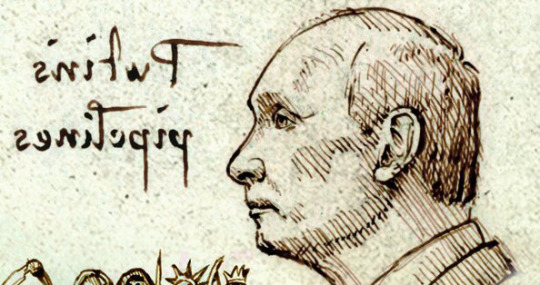
The other head of state featured on the cover is Vladimir Putin with the words “Putin’s pipelines”. This is a reference to the natural gas pipelines that are being built by Russia, in Syria, the Post-Soviet States, and even Europe. NordStream 2, a natural gas pipeline linking Russia to Germany, is set to be completed in 2019. This highly controversial project was deemed to be “act of betrayal” from Germany as critics say it will leave Europe at the mercy of Russian energy.
TurkStream, a Russia-Turkey pipeline, was launched in November of 2018 and will help consolidate Russia’s economy and regional influence.
Pinnochio
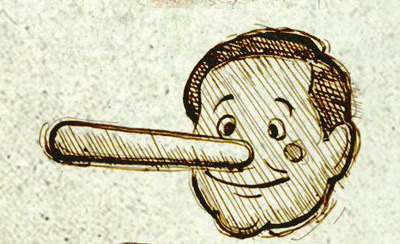
Right behind Putin is Pinnochio – a puppet whose nose grows after telling a lie (Fun fact: The tale of Pinocchio is also a profound Masonic allegory). So the cover implies that someone will lie in 2019. But who? Trump and Putin (the only two politicians on the cover)? The elite in general? Kanye West? No clear answer. It’s just The Economist telling the masses that they are being lied to in general. Thanks, guys.
Four Horsemen

Right under Putin, standing on Northern Europe and facing America, are none other than the Four Horsemen of the Apocalypse. The Book of Revelation describes the Horseman as harbingers of the Last Judgement. The White Horse is said to symbolize Conquest, Pestilence and the coming of the Anti-Christ; The Red Horse represents War; the Black Horse is associated with Famine, and the Pale Horse brings Death. That’s some heavy-handed catastrophe-predicting stuff.
Why did The Economist add this extremely ominous Biblical figure on its cover? There is no clear explanation.
Stork

This one can be interpreted in a few ways, and all of them are upsetting. It is a classic depiction of a stork carrying a newborn baby. However, there’s one important detail: There’s a barcode on the bag carrying a baby.
This might be a reference to “designer babies”, a controversial practice that should gain momentum in 2019.
A designer baby is a human embryo which has been genetically modified, usually following guidelines set by the parent or scientist, to produce desirable traits. This is done using various methods, such as germline engineering or preimplantation genetic diagnosis (PGD). This technology is the subject of ethical debate, bringing up the concept of genetically modified “superhumans” to interbreed with and eventually replace modern humans. – Wikipedia
The second meaning of this image could be child trafficking. Barcodes are placed on products to track inventory and to complete transactions. Child trafficking is about treating human as products to be sold. It’s a pretty effective (and disturbing) way of symbolizing child trafficking.
Finally, considering the fact that the stork is right under the Four Horsemen of the Apocalypse, this image could also have a biblical meaning. The Book of Revelation states that, after the rapture, people on Earth would be forced to receive the “mark of the Beast” (666) in order to “buy or to sell”. What better way to force a person to receive the mark of the Beast than by applying it at birth?
Other Images
The cover contains several other images referring to events The Economist is predicting to come in 2019. Here’s a quick rundown.
At the top of the cover, an arrow points from da Vinci’s flying machine towards the moon. This might be a reference to the many private companies aiming to travel to the moon in 2019. It should also be noted that we’re seeing the crescent moon on the cover, the main symbol associated with Islam.
There’s another “flying machine” (a real one) under the words “New Horizons of Ultimate Thule”. This refers to NASA’s New Horizons spacecraft getting close to the mysterious, distant object Ultima Thule on New Year’s Day.
Under the moon is a volcano. Are we expecting another volcano to be erupting soon?
At the bottom left (standing on Brazil) is a pangolin, which is the trafficked mammal on earth. It is under the threat of extinction.
2019 will be the 150th anniversary of Gandhi’s birth; It is also the 200th anniversary of Walt Whitman’s birth (shown under Pinnochio).
Angelina Jolie is the face of Mona Lisa – da Vinci’s masterpiece. At the top of the cover we see “Angelina Jolie: Responding to Refugees”. She might be used to promote the UN’s new “Migration Pact”. Indeed, Jolie is currently the Special Envoy for UNHCR, the UN Refugee Agency. She focuses on “major crises that result in mass population displacements, undertaking advocacy and representing UNHCR and the High Commissioner at the diplomatic level”.
In Conclusion
The cover of “The World in 2019” is an apt reflection of the occult elite. It mixes occult symbolism with references to the control and manipulation of the masses. It also takes a bizarre pleasure at predicting catastrophic events while keeping people guessing with vague and unexplained references. The elite likes to withhold information and reverse writing emphasizes this fact.
At the center of it all is the Vitruvian Man, a symbol used by the Masons to represent a human reaching full potential. However, the 2019 version is blinded and distracted by things pushed by the elite. Will we allow ourselves to follow the bleak path that they predict?
0 notes
Text
Cái đuôi dài | Chris Anderson
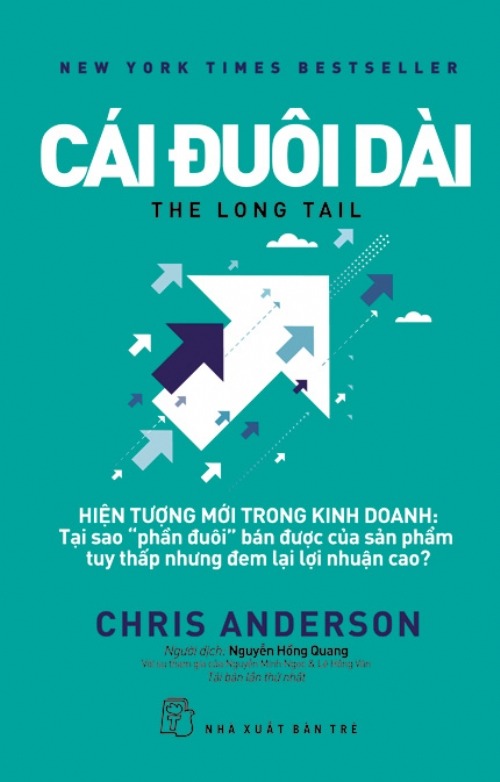
Cuốn thứ 10 hoàn thành trong năm nay. Chủ đề của nó nói về mô hình ‘cái đuôi dài’ đóng dấu copyrights bác Chris Anderson, Editor-in-Chief và cây bút gạo cội của tạp chí công nghệ Wired của Mỹ.
Về chất lượng dịch, mình đành phải nói ngay là…khá tệ dù đã tái bản đến 8 lần, đặc biệt là ở nửa cuối cuốn sách. Mình có cảm giác các dịch giả và editer đã hết sức cố gắng để dịch cho tròn nghĩa của câu văn, nhưng càng đọc mình thấy các bạn ấy càng đuối sức. nhất là các đoạn có nhiều thuật ngữ về lập trình, khoa học máy tính, thương mại điện tử…Mạch văn nó liên đới với nhau, hổng một đoạn là hổng luôn các đoạn sau, thậm chí cả chương, đọc càng về sau càng mù mờ tối tăm.
mình hiểu chuyện dịch term kỹ thuật không phải đơn giản, mình từng dịch bài cho báo PC-World hồi nó còn cực thịnh những năm 90-2000 và một số diễn đàn kỹ thuật, báo điện tử tựa như VOZ bây giờ, còn gần đây nhất là những term kỹ thuật trong lĩnh vực xe hơi. tra cứu điên loạn cào cào mới ra được một câu, phải đi check với dân kỹ thuật coi họ có đồng ý không, khá mất thời gian, nhưng mà thấy xứng đáng lắm. mình hy vọng nhà xuất bản Trẻ sẽ chỉnh sửa hoàn thiện bản dịch cho lần tái bản sau vậy.
cuốn này xuất bản năm 2007, tới giờ là 10 năm. những khái niệm và dự đoán của Chris Anderson viết trong Cái đuôi dài có cái đúng, có cái không. nhưng cảm nhận của tớ khi đọc cuốn này là Chris Anderson đã rất lạc quan, hay hơi get high một tí khi tìm được ‘mô hình thương mại’ đột phá. và Silicon Valley đã chộp lấy nó và đem vào mọi bài PR, thuyết trình, các CEO nói về nó như một thứ gì đó rất thời thượng.
nhưng hãy lùi ra xa một chút và nhìn nhận mọi thứ xem sao. năm 2000-2002 bong bóng dot-com bể, nhiều nhà đầu tư đặt kì vọng vào Sillicon valley vợ mộng. sau cuộc bể dâu đó lại là một làn sóng đầu tư mới lại từ từ bơm lên bong bóng công nghệ một lần nữa. cuốn Cái đuôi dài, xuất bản năm 2007 với đầy những nghiên cứu, quan sát từ những 2000-2007, và lạ thay như chưa từng có đổ vỡ dot-com trên đời, mô hình Cái đuôi dài tỏ ra lạc quan về tương lai công nghệ sẽ thay đổi Thế giới. Đến 2008, khủng hoàng tài chính làm Thế giới lao đao, mũi dùi trỏ vào giới tài chính, đầu tư vào công nghệ trở thành điểm đến an toàn cho các nhà đầu tư đang hoảng loạn. tại sao họ thấy yên tâm khi đầu tư vào công nghệ? vì dự đoán lạc quan vào công nghệ và không ít thì nhiều, lý thuyết ‘Cái đuôi dài’ tạo cho sự tự tin đó.
trong Lồng kính tự động hoá và chúng ta của Nicholas Carr và Mật mã văn hoá của Clotaire Rapaille và một cuốn tớ đọc cũng lâu lắm rồi Lời thú tội của một sát thủ kinh tế của John Perkins xuất bản năm 2004. chúng hé mở một góc nhìn khác về nước Mỹ, về khả năng viễn tượng hoá, về tính cách văn hoá thiên hướng vị thành niên, khả năng thổi phồng và tô hồng truyền thông có mục đích. và cuối cùng Wired thường được đánh giá là tờ báo có quan điểm cổ xuý cho công nghệ.
việc hệ thống hoá và cô đọng một học thuyết thành một cái tên hình tượng và có khả năng viral cao như ‘cái đuôi dài’, tớ nghĩ Chris Anderson đã làm cực kỳ tốt. cảm giác mọi người trong giới công nghệ nói về Cái đuôi dài của Chris Anderson như cách mọi người nói về thuyết tiến hoá của Darwin vậy.
anyway, dù sao tớ cũng đi hết cuốn Cái đuôi dài, cũng thu gom được nhiều điều trên đường đi. dù dịch thuật có nhiều sạn, nhưng cũng đáng để đọc lắm.
nay có hứng hay sao ấy mà viết bài thu hoạch siêu dài 😳 dài như cái đuôi dài 😂
5 notes
·
View notes
Photo

Yusron Fuadi, Director of Tengkorak Film - From Zero To Hero Kalau kamu ingin bikin film panjang yang bisa menghentikan kamu cuma kamu sendiri Beberapa pekan lalu saya berkesempatan mendatangi JAFF ke-12 di Jogja. Sebuah perhelatan festival film paling berpengaruh bagi perfilman Indonesia. Hadir saat itu seorang sineas muda yang filmnya juga tayang dalam perhelatan tersebut. Teman saya itu bernama Yusron Fuadi, sutradara dari film berjudul Tengkorak. Filmnya lolos seleksi perhelatan JAFF, bahkan masuk dalam Special Gala Screening. Sebuah program khusus yang dibuat oleh pihak JAFF untuk mengapresiasi film Indonesia yang menjadi sorotan utama tahun ini. Hanya ada 2 film yang masuk dalam Special Gala Screening, Tengkorak dan Mobil Bekas dan Kisah-kisah dalam Putaran (Carousel Never Stop Turning) karya Ismael Basbeth. Malam itu saya berkesempatan berbincang dengan Pria yang juga dosen UGM yang kerap dipanggil Mas Yos ini, berikut penggalan obrolan penuh kelakar kami; Saya (S): Mas... Yusron Fuadi (YF): heh koe entuk tiketku ora? (eh kamu dapat tiketku tidak?) S: wah gak dapat e.... Mas, film mas masuk JAFF kali ini bahkan masuk dalam special screening juga, tanggapan mas? YF: apa ya.... bahwa film saya itu bukan tipe film (untuk ditayangkan di) JAFF gitu. Pada saat pendaftaran itu berdoa aja, semoga masuk. Jadi sak studio (seluruh studio) termasuk kru-kru ku yang masih muda-muda itu langsung "yeaaaah" waktu film ku dinyatakan lolos seleksi. "Iki tenan ora iki (ini bener apa gak)" "wah iki hoak iki (ah jangan-jangan Hoax aja)" bahkan aku sampai ngecek, kan dapat surat gitu, iki tenanan ora (ini beneran ga sih), soalnya filmku bukan film tematik atau film dengan tema-tema penting gitu. Lalu aku telpon panitianya "ow ya masuk mas". Ya lumayan lah buat batu loncatan gitu. S: tapi dengar-dengar, koreksi kalau saya salah, filmnya mas ini cukup ditunggu-tunggu sama penikmat film YF: ya kalau ditunggu-tunggunya ya ga tahu. Serius aku ga tahu. Aku ngeceknya dimana aku ga tahu (tertawa). Cuma saat online ticketing itu beberapa jam langsung habis. Terutama yang hari pertama. Beberapa hari kemudian pemutaran hari kedua juga habis. S: lalu tanggapan mas? YF: Surealis. Absurd. Ga percaya (tertawa) S: lho koq (tertawa) YF: karena producerku kan masih kecil-kecil ya masih 22 tahun mereka pada panik, ayo gimana caranya nanti kita cari penonton, yang online itu ada yang beli, eh ujung-ujungnya mereka sendiri ga kebagian. Sedih sekaligus aku senengnya bukan main. I'm happy for them. Karena ini bukan film ku saja, ini filmnya 'umat', filmnya orang banyak. S: filmnya rame-rame... YF: Ya filmnya rame-rame. Collective Happiness nya itu lho yang arrrrghhh (menjerit tertawa) S: apa harapannya kedepannya mas? YF: semoga dengan ini aku jadi punya 'bahan bakar' untuk tayang di XXI. Dah itu aja (tersenyum) S: apakah sejauh ini ada kesulitan untuk tayang disana? YF: belum ada sih. Cuman sejauh ini aku belum cukup pede. Tapi melihat respon kemarin (penjualan tiket online) aku jadi agak pede untuk nawarin ke XXI. Entah endingnya kayak gimana. S: berarti masih ada harapan untuk tayang kesana? YF: ada. Aku pingin nawarin film ini ke XXI dan jaringan bioskop regular (tertawa terbahak-bahak). Karena dirimu kan tahu produksinya... S: ya... ya... YF: bahkan tak ada orang perfilman, godfather sekalipun di belakangku (support finansial). Pure our Blood and sweat. S: dan dengan tekad yang kuat begitu YF: ya dengan tekad yang kuat. S: bisa tolong diceritakan sedikit saja filmnya tentang apa, produksinya bagaimana? YF: ini film genre fiksi ilmiah masih agak sedikit di garap di tanah air, premise nya sendiri apa yang terjadi pada umat manusia dan masyarakat, jika kita menemukan fosil kerangka manusia setinggi 2km. Ini bukan film horor. Ini bukan film monster. Tapi aku mengangkat kekacauan seperti apa saat para akademisi tak punya jawabannya. Saat Kyai-kyai juga tak punya jawabannya begitu. S: Premis nya cukup dalam ternyata ya... YF: sebetulnya... iya. Semoga sih filmnya juga cukup dalam (tertawa). S: Produksinya sendiri bagaimana mas apakah ada kendala? YF: aku mulai komit (berkomitmen) menggarap film ini, shooting film ini, tahun pertama itu biayanya cuma dari gaji dosenku 1,8 juta. Perbulan. S: serius mas? Wow... YF: aku Shooting kalau aku punya uang. That's it. Setahun pertama itu. "70% adegan dalam film ini nanti jadinya seperti apa ya mas Yusron?". (Aku jawab) "Ora reti (Ya ga tau)" (sambil tertawa). Cuma memasuki tahun ke 2 menarik beberapa orang yang teracuni dengan semangat kami. Orang-orang penting. Dekan yang "koe ki gawe opo to Yus? Kurang gawean banget (kamu ini sedang buat apa sih Yus? Koq seperti kurang kerjaan sekali)" jadi ya melihat sepak terjang sekaligus kami yang terlunta-lunta dalam membuat film tapi terbukti bahwa tim kami itu tidak terhentikan. Meskipun kru-kru nya hanya dibayar nasi pecel lele (tertawa). S: serius mas hanya pecel lele? (Tertawa) YF: serius (tertawa). Kami tetap jalan. Shooting, edit, shooting, edit. Kalau kamu ga shooting itu berarti kami ga punya uang. S: kalau kita ngomongin soal Budget, kalau mas BW (BW Purbanegara film Ziarah) Budget ditangani dengan membuat dan menjual Merchandise. Kalau Mas yusron sendiri bagaimana? YF: kalau budget tahun pertama benar-benar dari gajiku sebagai dosen, kadang dapat penelitian tak arahkan seputar visual efek atau animasi untuk film itu. Ya lumayan lah dapat 1 scene agak mahalan dikit gitu (tertawa), sementara 70% adegan lain piye ngono (gimana gitu). Tapi setelah kita dibantu oleh pak Dekan Vokasi UGM, kita dikenalkan sama orang-orang yang bersedia ngasih sumbangan untuk membantu kami menyelesaikan film ini. Endingnya budget itu buat bikin set, bikin properti. Karena hanya karena film ini indipenden dan tak ada orang besar di belakang bukan berarti saya nge-cut (memotong) Production Value. Saya ingin film tetap jalan. Kalau pun kita mau shooting di puncak gunung merapi kita akan shooting di puncak gunung merapi. Kalau kita ingin shooting yang menggambarkan Jogja sepi sementara kita ga bisa nyetop jalan kita akan Shooting pada Idul Fitri jam 6 pagi. S: mas ini JAFF ke-12. Bagaimana Mas memandang festival film ini? YF: sebetulnya film pertama ku, film pendek yang judulnya Pendekar Kesepian juga diputer disini. Filmku itu somehow bukan film festival atau film kompetisi. "Yusron film mu terlalu aneh untuk ikut kompetisi sron" (tertawa sambil menirukan), ya terima saja. S: melihat animo malam ini dan JAFF kali ini mas? YF: sebetulnya aku ini orang jogja dan aku harus bekerja di kapal selama 3 tahun sejak 2012 aku kayak orang ga tahu apa-apa gitu lho. Kalau kamu liat disini, aku tuh kayak orang hilang. Aku cuma kenal dia (menunjuk seorang teman). Jadi ya. Seingatku JAFF itu selalu rame sih sudah seperti Jogja punya Artjog itu kan sudah dapat audience nya. Ga usah bingung screening itu nanti ada yg nonton apa ndak. Kalau animonya wes oye (udah bagus). S: ini kalau kita bicara soal film dan JAFF... YF: wah aku ki pingin koe nonton film ku e... S: pasti sebisa mungkin saya nonton. Nonton paling depan ga apa deh (tertawa). Tapi kalau melihat Film, dan sineas muda, apa pesan buat mereka? YF: ini versiku ya, langsung ke film panjang aja ya karena aku sudah mengalami itu, sineas muda itu takut membuat film panjang sebelum nyantrik (dibantu) nama besar, sebelum ada dana besar di belakangnya, Itu gak benar. Kalau kamu ingin bikin film panjang yang bisa menghentikan kamu cuma kamu sendiri. That's it. Bikin film panjang itu cuma butuh dengkul, sama hati, sama kepala. Wes (sudah). Sama teman-teman. Dan jalan. Nanti kalau kamu liat filmku ini bukan film murah lho tapi kayak mahal. Asal otaknya jalan sih... S: dan semua elemen dimaksimalkan... YF: ya dan bersabar. Persistance gitu lho. 3 tahun e. Shooting pertama itu oktober 2014. Shooting terakhir 3 minggu yang lalu (tertawa) S: tapi mas masih berkeyakinan bahwa film ini tetap jalan dan jadi begitu ya YF: ya karena aku dikelilingi anak-anak muda yang mereka ga tahu apa-apa tentang film. "Berarti nanti kita pakai dslr atau handycam gitu ya mas ya?" (Dijawab) "sing penting koe ngewangi aku sik wae (yang penting kamu bantuin aku dulu saja)". Mereka itu kayak anak-anak yang masih polos tapi energinya ga habis-habis dan itu nyalur banget ke aku yang sudah tua. Film ini shooting 127 hari, dan mayoritas mereka ikut selama itu, that's mean... mereka ikut selama lebih dari 100 hari dan tak dibayar. Mencurahkan cinta dan air mata wes (tersenyum). Begitulah Yusron Fuadi sineas muda yang angkat nama lewat film terbarunya berjudul Tengkorak. Filmnya kemudian diganjar 2 kali full theater saat di tayangkan dalam program Special Gala Screening, bahkan meski tiketnya habis terjual para penonton setia mengantri mengular hingga keluar bioskop demi rela duduk lesehan dalam theater. Pada hari screening pertama Yusron secara pribadi ke pada saya mengungkapkan bahwa filmnya lolos seleksi festival film Cinequest di Sillicon Valley San Francisco Amerika Serikat awal tahun depan. Sebuah perhelatan festival film besar di negara tersebut. Ini lah bukti kegigihan Yusron Fuadi yang memulai filmnya dari cita-cita, tekad, dan situasi budget filming yang minim, dan kecintaan akan Star Wars saga film favoritnya. Semoga Tengkorak berjaya di Cinequest dan dapat mengharumkan nama Indonesia dan perfilman tanah air. View on Path
#film tengkorak#tengkorak#skull#yusron fuadi#interview#film#sci-fi#indonesia#jaff#Jogja-NETPAC Asian Film Festival
0 notes
Video
youtube
Morning Earworm: Disposable Edition: This is almost certainly from a Comcast or Time Warner or some other such commercial -- which is was Flo Rida makes music for, let’s be honest. Every track is just a jingle in search of a licencing deal. But at least he’s fairly up front about that. Besides, any time I hear Flo Rida now, I think of this scene from Sillicon Valley, and that’s cool with me.
0 notes
Text
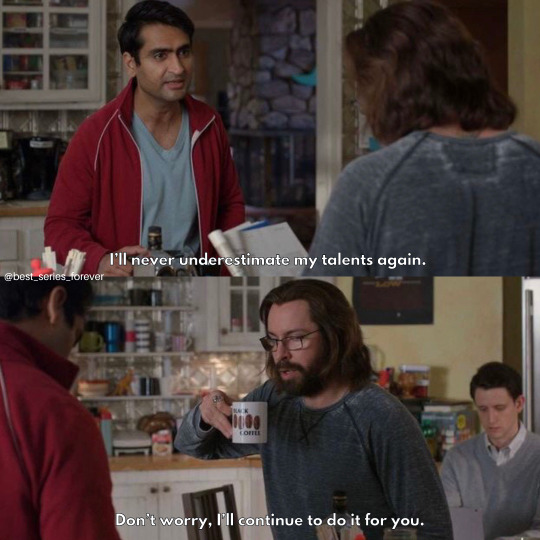
#sillicon valley edit#series#fyp#best series forever#sillicon valley#hbo max#hbo#funny#fy#season#quotes
1 note
·
View note
Text

#sillicon valley#series#fyp#best series forever#season#fy#sillicon valley edit#hbo#sillicon valley hbo#series gifs#gifs
0 notes
Text
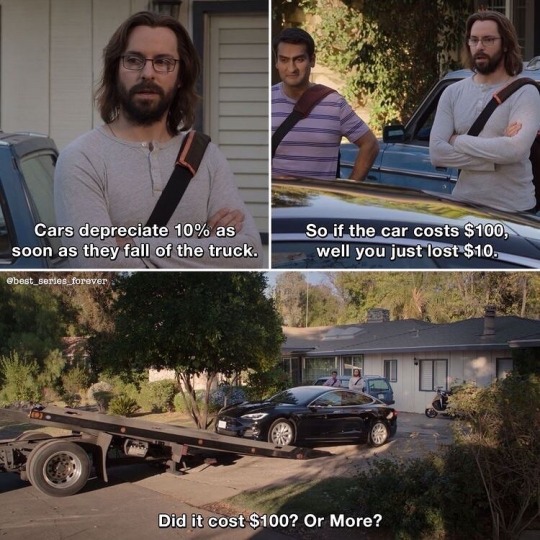
#sillicon valley#season#series#best series forever#fyp#hbo max#funny#hbo#quotes#Tesla#series quotes#sillicon valley edit
1 note
·
View note
Text

1 note
·
View note